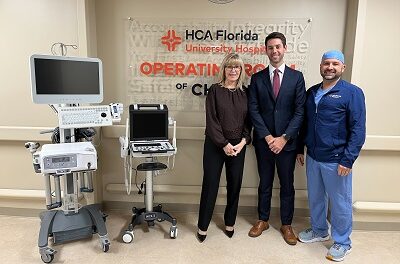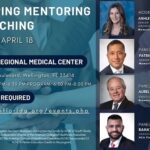November 12 2021 – Amid more than 1,100 COVID-19 deaths per day and approximately 75,000 new cases nationally per week, American Medical Association President Gerald E. Harmon, M.D., today addressed the Special Meeting of the American Medical Association (AMA) House of Delegates and outlined ongoing challenges physicians are facing in the fight against COVID-19. He also praised physicians and other frontline health care workers battling the virus, discussed burnout challenges he sees, highlighted regulatory and bureaucratic obstacles to patient care that the AMA is fighting, and urged Congress to address the looming end-of-year Medicare cuts that could cut payments to physician practices by nearly 10 percent when they are already struggling due to the pandemic.
In his remarks, Dr. Harmon touted AMA efforts to: secure PPE and financial resources for practices; provide resources and evidence-based information on COVID physicians needed during a time of mixed messages; and work with CMS to expand telehealth.
Video of Dr. Harmon’s speech is available here.
Dr. Harmon also recalled a recent 100-hour teaching rotation at his South Carolina hospital, where, with the Delta variant surging and vaccination rates lagging, the ICU was operating well above capacity, full of largely unvaccinated COVID patients.
“I want you to imagine a small community hospital in a rural area of a southern state, a year and a half into the pandemic,” he said. “The COVID Delta variant is surging, and the vaccination rate lags. Both the hospital and the ICU have been operating well above 100 percent capacity for more than a month.
“The ICU is filled with COVID patients (90% of whom are unvaccinated and 2/3 of them under age 60), and inpatient beds overflow into the hallways. Emergency room and PACU beds double as Critical Care beds as patients struggle to breathe.
“With these younger, sicker patients comes a new dynamic for many doctors and nurses. They must witness young families and their children watching through barriers or covered in PPE as their loved ones succumb to a devastating virus. These health workers are taking extra shifts and giving it their all, but are showing signs of exhaustion as they deal with the physical and emotional trauma. Young clinicians, in particular, appear shell-shocked, and seem to be questioning their career choices.
“To many of you, this sounds all too familiar. And, in fact, the scenario I just described took place at my community hospital in Georgetown County, South Carolina, during a grueling seven-day, 100-hour teaching rotation I led.
“The fear and weariness in young clinicians’ faces was not unlike what I witnessed in the medical arena in Iraqi Freedom and Enduring Freedom after 9/11 – I’d call it battle fatigue. Like combat, the unrelenting demands of responding to COVID patients has led to physical and emotional exhaustion and pushed physicians and our entire health care workforce to the breaking point.
“What will the lasting effects of this pandemic be on young doctors? Will they leave their chosen specialties – or even the profession? What will it mean for the future of health care?
“We don’t have those answers – yet. And that is a difficult feeling to live with, day after day.”
The full text of Dr. Harmon’s remarks, as prepared for delivery, is below:
Why Organized Medicine Matters
Mister Speaker, officers, delegates, physician colleagues, distinguished guests.
Had enough of these virtual meetings yet? This is our fourth in a row – but who’s counting?
First, let me thank each and every one of you who has responded to the pandemic. Physicians have shown great courage in the face of difficulty over the past many months . . . even up until this very day … as the battle goes on. My physician colleagues – my battle partners, indeed my fellow Covid veterans – soldier on answering the call.
Yet even as the Delta surge wanes, we anticipate entering a third calendar year of the global pandemic and have surpassed 750,000 lives lost to COVID in the U.S. alone. Just a staggering and heartbreaking milestone to reach. And many questions remain. Are we near the end? Will there be another surge? Will vaccinations hold up against future mutations?
We do not have those answers. Yet.
I want you to imagine a small community hospital in a rural area of a southern state, a year and a half into the pandemic. The COVID Delta variant is surging, and the vaccination rate lags. Both the hospital and the ICU have been operating well above 100 percent capacity for more than a month.
The ICU is filled with COVID patients (90% of whom are unvaccinated and 2/3 of them under age 60), and inpatient beds overflow into the hallways. Emergency room and PACU beds double as Critical Care beds as patients struggle to breathe.
With these younger, sicker patients comes a new dynamic for many doctors and nurses. They must witness young families and their children watching through barriers or covered in PPE as their loved ones succumb to a devastating virus. These health workers are taking extra shifts and giving it their all, but are showing signs of exhaustion as they deal with the physical and emotional trauma. Young clinicians, in particular, appear shell-shocked, and seem to be questioning their career choices.
To many of you, this sounds all too familiar. And, in fact, the scenario I just described took place at my community hospital in Georgetown County, South Carolina, during a grueling seven-day, 100-hour teaching rotation I led.
The fear and weariness in young clinicians’ faces was not unlike what I witnessed in the medical arena in Iraqi Freedom and Enduring Freedom after 9/11 – I’d call it battle fatigue. Like combat, the unrelenting demands of responding to COVID patients has led to physical and emotional exhaustion and pushed physicians and our entire health care workforce to the breaking point.
What will the lasting effects of this pandemic be on young doctors? Will they leave their chosen specialties – or even the profession? What will it mean for the future of health care?
We don’t have those answers – yet. And that is a difficult feeling to live with, day after day.
Our psychiatry friends will tell you that the human brain is challenged by uncertain situations and outcomes. Faced with uncertainty, we may feel threatened, unable to concentrate, less capable of solving problems.
During such uncertain times, it is critical that we find support and social connection.
Where will physicians – especially young doctors and those in training — find that support?
I would submit that we must be their support. We at the AMA … and all the state and specialty medical societies who comprise the House of Medicine … must be the allies our physician colleagues need right now.
A few months ago, one of our Federation partners, the West Virginia State Medical Association, asked me to speak to the question, “Do we still need organized medicine?”
You might think the answer is obvious . . . “Heck yeah!” But here’s why . . .
Throughout this pandemic, the AMA and our state and specialty medical associations have stepped up and bridged many gaps . . . getting doctors and other health care workers the information, PPE and other resources they needed, even as state and federal governments struggled in a deficient public health system.
And when I use the term “organized medicine,” I don’t mean an abstract concept. I mean our people, our common purpose, and our actions in support of a profession built on ethics and science, and that is focused on providing the best possible care for patients in ways that also strengthen our communities.
“Organized medicine” means hundreds of thousands of physicians, students and trainees from every state and specialty in the United States … gifted and talented practitioners, researchers and academics.
“Organized medicine” means our common purpose … which is “to promote the art and science of medicine and the betterment of public health.” Our mission statement.
And “organized medicine” refers to those specific actions we are doing to help physicians meet the challenges of this pandemic and beyond.
When we first encountered the novel coronavirus in early 2020, the AMA and our partners in organized medicine responded:
- We fought for PPE and financial resources;
- We were a reliable source of evidence-based info on COVID physicians needed during a time of mixed messages;
- We worked with CMS to expand telehealth and pause the regulations standing in the way;
- We pushed insurers to drop prior authorization requirements; and
- Importantly, we fought against misinformation and disinformation at every step.
We continue to call out half-truths and lies – and we are educating those who are open to science-based information.
Colleagues, do not believe the myth that all who are unvaccinated are hardened in that position. In fact, research shows that if we, as physicians, recommend vaccines to our patients, they are inclined to take them.
My state still only has a little over half the population vaccinated. Last month, I spoke to group of maybe 50 employees about vaccines – and used the point that many in the community had either trusted me personally, or their families had trusted me with their medical care, from sprained ankles to heart attacks and cancer.
Yet they still had hesitations and questions about the Covid vaccine – largely due to nonstop misinformation – and I reminded them they had sought my advice for decades. My advice was to “take my advice! Take the vaccine.”
Afterwards many of the vaccine-hesitant stepped up and thanked me and said I’d convinced them – when could they get the shot?
My story, multiplied by those from colleagues across the country, speaks to the power we have as individual physicians, and in turn, the power, the reach and the impact we can have as organized medicine … as purveyors of truth on the side of science.
But as this audience knows, the value of organized medicine is much broader than pandemic response.
Challenges in medicine existed long before COVID-19, and will continue long after the worst is over.
Physicians face bureaucratic and regulatory obstacles to care that contribute to burnout, and organized medicine has not lost sight of those battles. In fact, the pandemic has shined a spotlight on the breadth of challenges we face:
- A dysfunctional Medicare physician payment system
- Scope of practice expansion
- Electronic records/data transparency
- Chronic disease management
- Prior authorization
- Health disparities and equity concerns
We have committed teams at the AMA working on each of these health care challenges – and many more – and I am so grateful for their efforts.
Let me highlight three issues that are of utmost importance to us right now.
First, we need the strength of organized medicine in the battle against Medicare payment cuts … a battle that must be re-fought again this year.
We are facing potential Medicare cuts of nearly 10 percent beginning in January, 2022!
It is time that Congress passes a permanent solution to end these annual battles that threaten the solvency of physician practices … and Congress must address physician budget neutrality and inadequate annual payment updates as the root causes.
Next, we need the strength of organized medicine to fight aggravating payer policies that hurt rather than help patients. Now, I will keep this speech in the ‘PG rating’ mode, but I must use at this point what all of us consider a dirty word: Prior Authorization.
Recently a patient presented with some ill-defined symptoms – slight cognitive impairment with intermittent complaints of difficulty walking, especially on the golf course. He was over 70, had moderate hypertension and diabetes, and was being followed by a Physician Assistant working with an endocrinologist and, less often, seeing his primary care doctor. He’d had a benign CT of his head, and the feeling by many of his providers was tending toward vascular dementia or Parkinson’s, given his risk factors.
I wondered about Normal Pressure Hydrocephalus and ordered an MRI of his brain. His Medicare Advantage plan’s benefits manager pushed back on the study and denied the imaging. I disagreed and spent 30 minutes on the phone arguing, finally prevailing. Sure enough, the MRI was consistent with NPH with enlarged ventricles and my neurosurgeon colleagues are now taking him to surgery.
If we had not fought this decision, the delay in care would likely have resulted in the patient’s condition deteriorating, causing greater disability and even death down the road. That’s just foolish. But when an insurance company is making the decision rather than a physician, it’s probably going to be in favor of short-term financial gain.
That’s why the AMA is pushing for legislative action on prior authorization and step therapy reforms at the federal and state levels.
And finally, we also need the strength of organized medicine when it comes to correcting the past wrongs of our profession, and creating a health care system that is responsive to the needs of all patients.
The impact of systemic racism in medicine – past and present – is real. The pandemic and social unrest of the past 20 months has shown all too clearly how policies such as segregation, mass incarceration, police brutality, and redlining continue to adversely affect the health of Black and Brown individuals and communities.
We are committed to our strategic plan to embed equity and racial justice within the AMA and within the larger health care system. This plan is ambitious and far-reaching. It will be the subject of an educational session during this meeting, and I encourage everyone to attend to learn more. Our work to date has been earnest, it has noble ambitions, and it is critical to the health of our nation.
The point is, a single physician cannot bring about the legislative or regulatory changes needed to improve the practice environment.
But membership in organized medicine multiplies our power, our resources, and our voice, by hundreds of thousands of physicians.
I was a big fan of the late General Colin Powell, who famously said ‘perpetual optimism is a force multiplier.” I myself have been accused of being “pathologically optimistic,” and want us to remain focused on all that we face.
But I can assure you that we haven’t lost the fight, whether we are talking about COVID-19 or burnout or any other challenge.
The AMA and its Federation partners are strong. We are an army against the virus. We are an army against injustice. An army against unresponsive bureaucracy and distracted legislators.
We are strong in support of our colleagues, individually and collectively. Strong in envisioning the end to this pandemic and a brighter age for health care.
There will yet be uncertain times ahead, but we can walk with confidence into the future, because through organized medicine, we know we are not walking alone.
It’s been a long two years, but I encourage you to persevere through what remains a consequential time in our nation’s history and the history of medicine. I encourage us, once more, to “Act Worthy of Ourselves” on behalf of future generations.


























